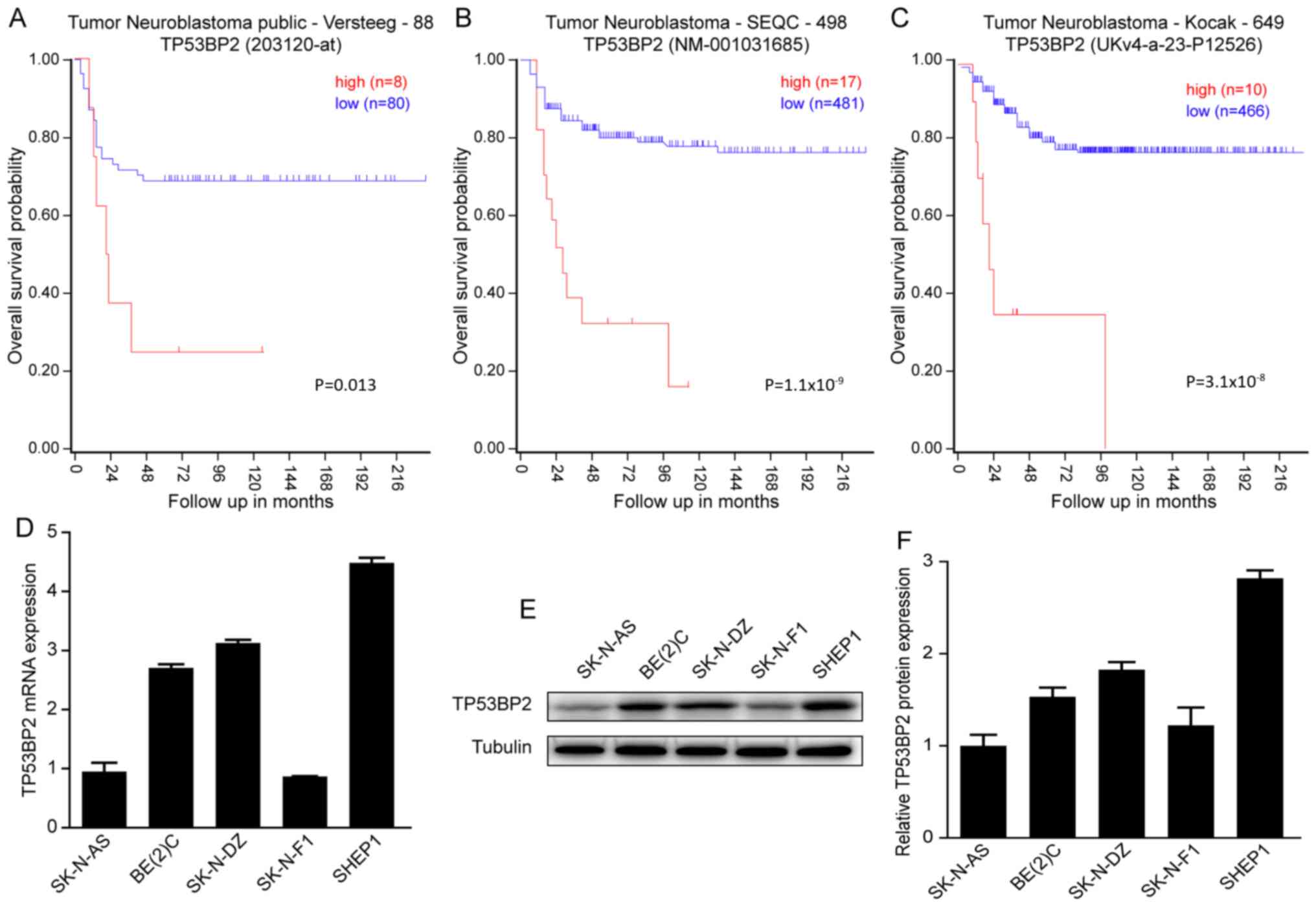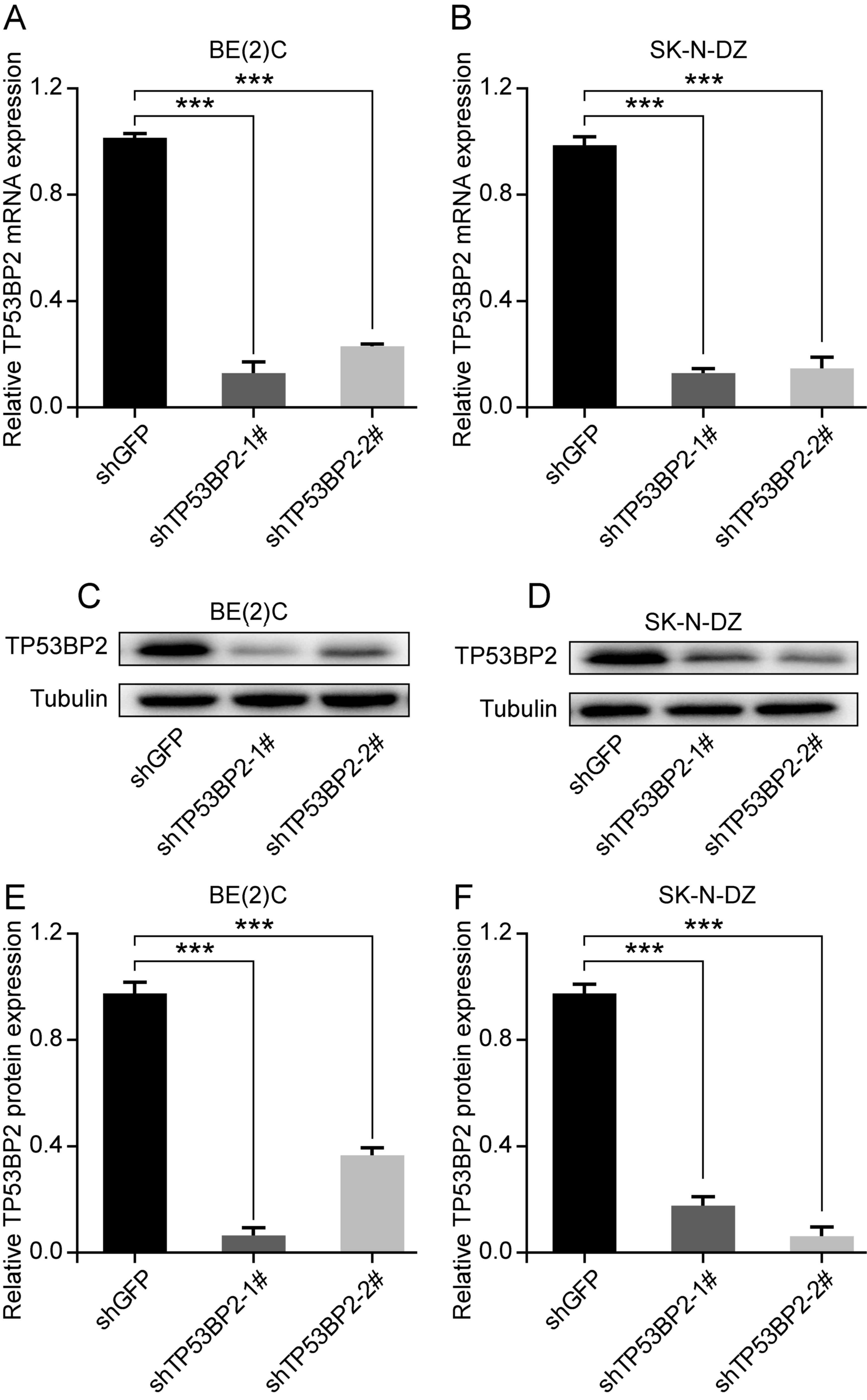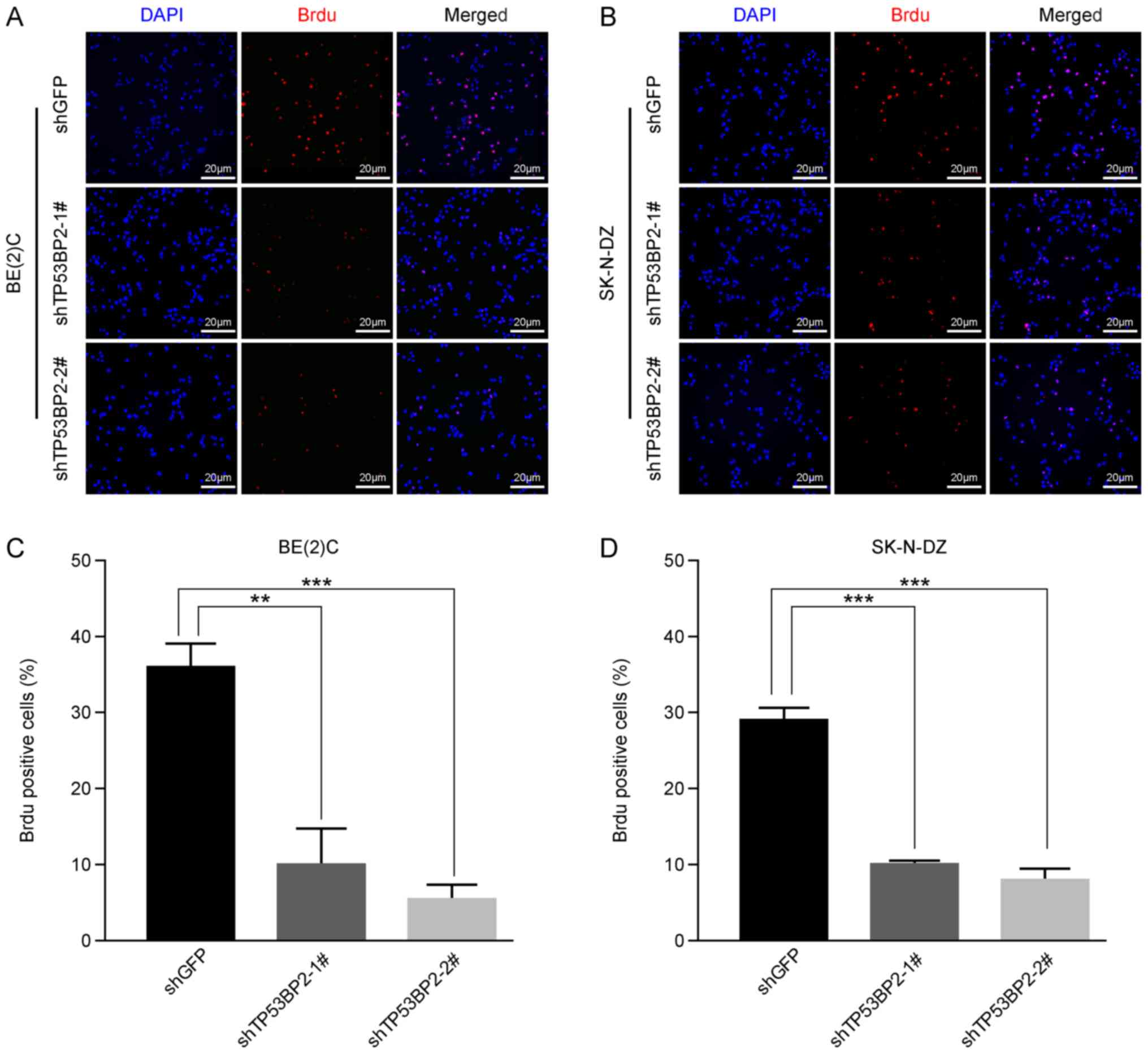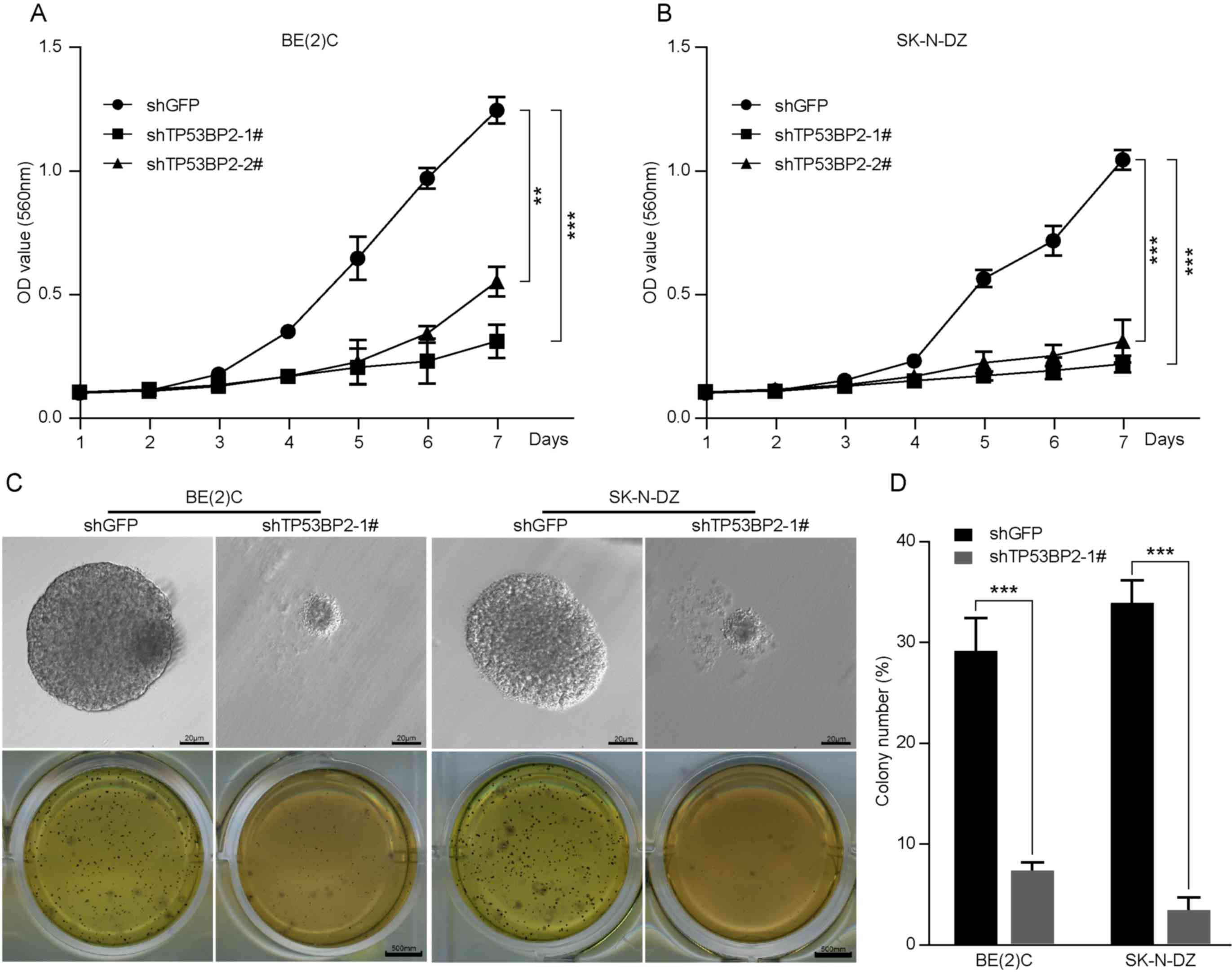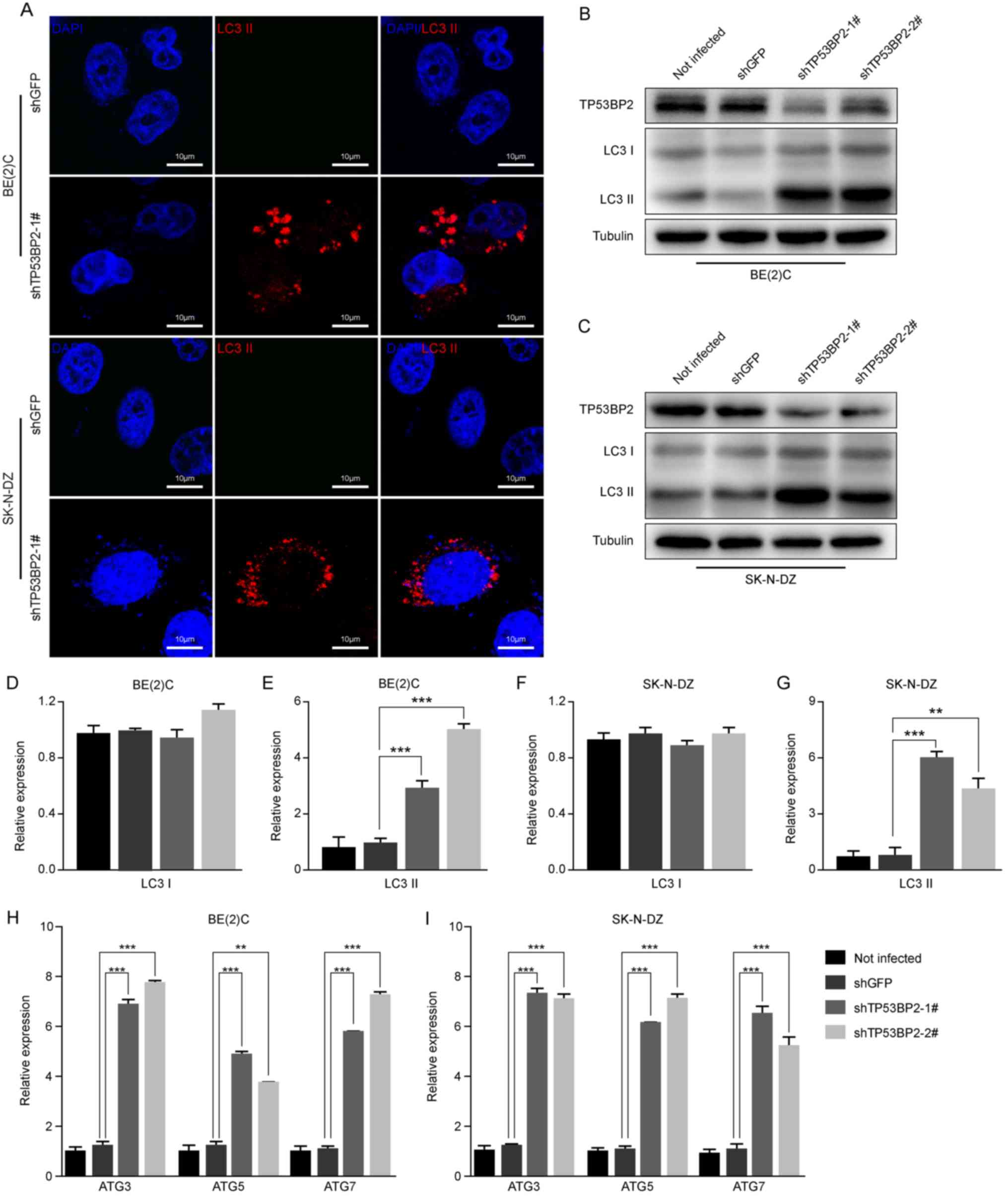TP53BP2 decreases cell proliferation and induces autophagy in neuroblastoma cell lines
- Authors:
- Published online on: March 15, 2019 https://doi.org/10.3892/ol.2019.10148
- Pages: 4976-4984
-
Copyright: © Pang et al. This is an open access article distributed under the terms of Creative Commons Attribution License.
Abstract
Introduction
Neuroblastomas are common pediatric extracranial tumors of neural crest origin that account for 10% of cancer cases in children and ~15% of cancer-associated mortalities in children (1–6). Clinical features of neuroblastoma include heterogeneity, high malignancy and metastasis (7,8). Common therapeutic methods include surgery, radiotherapy and chemotherapy, and novel methods include immunotherapy and differentiation therapy; however, the treatment of neuroblastoma remains unsatisfactory and the prognosis is poor (9). Therefore, an increasing number of studies have aimed to identify feasible biotherapies and drug targets (10).
TP53BP2 is a member of the apoptosis-stimulating protein of p53 (ASPP) family, which can regulate p53-dependent apoptosis (11). A number of studies have indicated that TP53BP2 is overexpressed in various tumor types, and is a critical factor in tumorigenesis and development (12,13). TP53BP2 inhibits squamous cell carcinoma by regulating p63 (14). In breast cancer, overexpression of TP53BP2 is often associated with a poor prognosis, and TP53BP2 can interact with microRNA-548d-3p to regulate proliferation and apoptosis (15). In gastric cancer, the expression of TP53BP2 is associated with tumor stage (16). Survival data from R2 genomic analyses in the present study indicate that TP53BP2 may be associated with the prognosis of patients with neuroblastoma; however, to the best of our knowledge, the role and molecular mechanisms of TP53BP2 in neuroblastoma have not been reported. Therefore, the aim of the present study was to investigate the mechanism of TP53BP2 in neuroblastoma and provide a theoretical basis for clinical treatment.
Autophagy is an evolutionally conserved mechanism that can degrade organelles, proteins, macromolecules and ribosomes via lysosomes, which is critical for the maintenance of intracellular stability and stress responses (17). There are four types of autophagy, including macroautophagy (also termed autophagy), selective autophagy, microautophagy and chapter-one-mediated autophagy (18–20). Autophagy consists of several key steps, including initiation, nucleation, expansion and maturation of autophagosomes. A number of autophagy-related (ATG) genes participate in autophagy (21–23). Previously, autophagy has been reported to be associated with pathological and disease processes, including infectious diseases, autoimmune diseases, myopathy, neurodegenerative diseases and cancer (21,24,25). The present study demonstrated that TP53BP2 can regulate proliferation and autophagy of neuroblastoma cells. Knockdown of TP53BP2 inhibited cell proliferation and increased the expression level of LC3 II (also termed LC3B). LC3 I is the precursor of LC3 II; LC3 I is activated when autophagy occurs and induces the production of LC3 II, which promotes autophagy (26). In summary, the results of the present study revealed that TP53BP2 may be used as a prognostic marker for neuroblastoma and may regulate the proliferation of neuroblastoma cells.
Materials and methods
Cell culture
The human neuroblastoma cell lines SK-N-AS, BE(2)C, SK-N-DZ, SK-N-F1 and SHEP1 were obtained from the American Type Culture Collection (ATCC; Manassas, VA, USA). The BE(2)C cells were cultured in a 1:1 mixture of Dulbecco's modified Eagle's medium (DMEM) and Ham's nutrient mixture F12 (DMEM/F12; Thermo Fisher Scientific, Inc., Waltham, MA, USA) with 10% fetal bovine serum (FBS; Thermo Fisher Scientific, Inc.) and 1% penicillin/streptomycin (P/S). SK-N-AS, SK-N-DZ, SK-N-F1 and SHEP1 cells were cultured in DMEM (Thermo Fisher Scientific, Inc.) with 10% FBS and 1% P/S. The 293FT cell line (ATCC) was cultured with DMEM (Gibco; Thermo Fisher Scientific, Inc.) containing 1% glutamine, glycine and pyruvate. All cells were incubated at 37°C in an incubator with 5% CO2.
Lentiviral infection
TP53BP2 short hairpin (shRNA) and green fluorescent protein (GFP) shRNA were purchased from BGI (Shanghai, China). The sequences of TP53BP2 shRNA (shTP53BP2) were as follows: shTP53BP2-1# forward, 5′-CACCGCAGAATGCCAAGCTACAACACGAATGTTGTAGCTTGGCATTCTGC-3′ and reverse, 5′-AAAAGCAGAATGCCAAGCTACAACATTCGTGTTGTAGCTTGGCATTCTGC-3′; and shTP53BP2-2# forward, 5′-CACCGCTGCAGTAGGTCCCTATATCCGAAGATATAGGGACCTACTGCAGC-3′ and reverse, 5′-AAAAGCTGCAGTAGGTCCCTATATCTTCGGATATAGGGACCTACTGCAGC-3′. The PLKO.1 vector (Thermo Fisher Scientific, Inc.) was digested using AgeI and BamHI, and the annealed human TP53BP2 shRNA was inserted into the PLKO.1 vector using T4 ligase. Subsequently, the vector was transformed and monoclonal clones were selected for sequencing. The plasmids were extracted using a plasmid extracted kit (Tiangen Biotech Co., Ltd., Beijing, China). Lentiviruses were generated by co-transfecting the 293FT cell line with the packaging plasmids pLP1, pLP2 and pLP/VSVG (all from Invitrogen; Thermo Fisher Scientific, Inc.) and the shRNA plasmids. Lipofectamine® 2000 (Invitrogen; Thermo Fisher Scientific, Inc.) was used for all transfections, according to the manufacturer's protocol. After 48 h, virus-containing media were harvested. BE(2)C and SK-N-DZ cells were plated at a density of 5×105 cells in 100 mm plates and cultured for 24 h. Subsequently, the virus-containing media were mixed with 4 µg/ml Polybrene (Invitrogen; Thermo Fisher Scientific, Inc.) and used for cell infection. At 24 h after infection, the medium was removed and cells were cultured with 2 mg/ml puromycin for 2 days. The cells were then selected for subsequent experiments.
Cell proliferation assay
MTT assays were used to investigate cell proliferation. Briefly, ~1,000 cells were seeded in 96-well plates with 200 µl DMEM/F12. After 24 h of culture, 20 µl MTT was added to each well and the cells were incubated for 4 h. Dimethylsulfoxide was added to the wells to dissolve the purple formazan crystals. After 10 min on a shaking table, the absorbance was determined at 560 nm using a microplate reader daily for 7 days. All experiments were performed independently in triplicate.
5-Bromo-2-deoxyuridine (BrdU) staining assay
For BrdU immunofluorescence staining, BE(2)C and SK-N-DZ cells were cultured in 24-well plates and incubated with 10 µg/ml BrdU for 45 min at 37°C. The cells were then washed with PBS three times and fixed for 20 min with 4% paraformaldehyde (PFA) at room temperature. Subsequently, the cells were exposed to 0.3% Triton X-100 for 5 min, treated with 1 mol/l HCl and blocked for 1 h with 10% goat serum (Thermo Fisher Scientific, Inc.) diluted with PBS at room temperature. The cells were then incubated with a monoclonal rat primary antibody against BrdU (1:200; catalog no. ab6326; Abcam, Cambridge, UK) for 1 h at room temperature and with Alexa Fluor® 594 goat anti-rat immunoglobulin G (IgG) secondary antibody (1:400; catalog no. A-21211; Invitrogen; Thermo Fisher Scientific, Inc.) for 1 h at room temperature. DAPI (300 nM) was used for nuclear staining for 15 min at room temperature. A Nikon 80i fluorescence microscope (Nikon Corporation, Tokyo, Japan) was used to observe the number of stained cells (magnification, ×200). Images of ten randomly selected microscopic fields were captured.
Soft agar assay
Soft agar assays were used to determine cell tumorigenicity. In total, 800 BE(2)C and SK-N-DZ cells were mixed with 0.3% Noble agar in DMEM/F12 and then plated in 6-well plates containing a solidified bottom layer of 0.6% Noble agar in growth medium. Following solidification, the plates were transferred to a 37°C incubator with 5% CO2. After 4 weeks, colonies were stained with MTT (1 µg/ml) for 30 min at 37°C and images were captured using a light microscope (magnification, ×200).
Reverse transcription-quantitative polymerase chain reaction (RT-qPCR)
RT-qPCR was used to determine the expression of mRNA. According to the manufacturer's protocol, 1 ml TRIzol® (Takara Bio, Inc., Otsu, Japan) was added to each group (shGFP-, shTP53BP2-1#- and shTP53BP2-2#-transfected cells, and untransfected cells), and the cells were then harvested and extracted for total RNA purification. The mRNA was reverse-transcribed into cDNA using Moloney murine leukemia virus reverse transcriptase (Promega Corporation, Madison, WI, USA). The mRNA expression levels of TP53BP2, ATG3, ATG5 and ATG7 were determined using the SYBR Green PCR Master mix (Takara Bio, Inc.) using qPCR. The qPCRs were performed in triplicate using the OneStep plus7500 RT-PCR system (Bio-Rad Laboratories, Inc., Hercules, CA, USA). The amplification conditions were as follows: 95°C for 10 min, 95°C for 15 sec, 60°C for 30 sec and 35 cycles of 30 sec at 72°C. The following primer sequences were used: GAPDH forward, 5′-ACGGATTTGGTCGTATTGGG-3′ and reverse, 5′-TCCTGGAAGATGGTGATGGG-3′; TP53BP2 forward, 5′-AGTCAGTTCCTTGTGGAGCC-3′ and reverse, 5′-CCGCAGAAACACCTGTGAAC-3′; ATG3 forward, 5′-TTGGCTATGATGAGCAACGG-3′ and reverse, 5′-CCCCTCCTTCTGCAACAGTCT-3′; ATG5 forward, 5′-TCAGCTCTTCCTTGGAACATCA-3′ and reverse, 5′-CCCATCCAGAGTTGCTTGTGA-3′; and ATG7 forward, 5′-TTTGCTTCCGTGACCGTACC-3′ and reverse, 5′-CTTTTCCCATCCAACTGCTTTA-3′. The data were analysed using the 2−ΔΔCq method (27). GAPDH was used as the control.
Western blot assay
SK-N-AS, BE(2)C, SK-N-DZ, SK-N-F1 and SHEP1 cells were digested with trypsin and washed twice with PBS. Cells were harvested and suspended in 1% radioimmunoprecipitation assay lysis buffer (Beyotime Institute of Biotechnology, Haimen, China). Protein concentrations were measured using a Bicinchoninic Acid protein assay kit (Beyotime Institute of Biotechnology). Total protein (50 µg) was separated using SDS-PAGE (30% gel) and then the proteins were transferred onto polyvinylidene difluoride membranes. Following blocking for 2 h with 5% goat serum (diluted with PBS) at room temperature, the membranes were incubated overnight at 4°C with the following primary antibodies: Anti-TP53BP2 (1:1,000, catalog no. ab181377; Abcam), anti-LC3 II (1:1,000; catalog no. ab48394; Abcam) and anti-tubulin (1:5,000; catalog no. ab7291; Abcam). The membranes were than incubated at room temperature for 2 h with horseradish peroxidase-conjugated anti-mouse IgG secondary antibody (1:10,000; catalog no. 04-18-06) or horseradish peroxidase-conjugated rabbit anti-goat IgG secondary antibody (1:10,000; catalog no. 14-13-06; both from KPL, Inc., Gaithersburg, MD, USA). Proteins were visualized using BeyoECL Plus reagent (Beyotime Institute of Biotechnology). Western blot data were quantified with Gel-Pro Analyzer 4 software (Media Cybernetics, Inc., Rockville, MD, USA).
Immunofluorescence assay
The expression of LC3 II was detected using immunofluorescence. In total, ~2×104 cells were seeded into 24-well plates, washed three times with PBS and fixed for 20 min with 4% PFA at room temperature. PBS with 1% Triton X-100 was then added for 20 min. Following three washes with PBS, the cells were blocked for 1 h with 4% goat serum (diluted with PBS) at room temperature. The cells were then incubated with a rabbit monoclonal antibody against LC3 II (1:100; catalog no. ab48394; Abcam) at 4°C overnight. Alexa Fluor® 488 goat anti-rat IgG secondary antibody (1:400; Invitrogen; catalog no. O-6382; Thermo Fisher Scientific, Inc.) was then added for 2 h at room temperature in the dark. DAPI (300 nM) was used for nuclear staining for 15 min at room temperature. Images of ten randomly selected microscopic fields were captured using a confocal microscope (magnification, ×2,000).
Patient data analysis
Patient data and gene expression datasets were obtained from the R2: Microarray analysis and visualization platform (http://hgserver1.amc.nl/cgi-bin/r2/main.cgi), which contains data from the ‘Tumour Neuroblastoma public Versteeg’, ‘Tumour Neuroblastoma-SEQC’ and ‘Tumour Neuroblastoma-Kocak’ datasets (28). These datasets contain mRNA expression data and no protein expression data. The Versteeg dataset contains 88 cases of neuroblastoma with tumor grade and gene variation. All prognosis analyses were performed with R2, and all data and P-values from a log-rank test were downloaded. Kaplan-Meier analysis was performed and the resulting survival curves were generated using GraphPad Prism 6.0 software (GraphPad Software, Inc., La Jolla, CA, USA). All cut-off values for generating high and low expression groups were determined using the online R2 database algorithm.
Statistical analysis
All data were analyzed using SPSS software (version 20.0; IBM Corp., Armonk, NY, USA). Quantitative data are presented as the mean ± standard deviation. One-way analysis of variance followed by Fisher's least significant difference test was used to assess significant differences. P<0.05 was considered to indicate a statistically significant difference.
Results
Increased expression of TP53BP2 is associated with poor prognosis of patients with neuroblastoma
To investigate whether TP53BP2 can be used as a prognostic indicator of neuroblastoma. A Kaplan-Meier analysis of progression-free survival for the Versteeg data indicated that an increased expression level of TP53BP2 is associated with a poor prognosis and a low expression level of TP53BP2 is associated with improved overall survival (Fig. 1A). Similar results were observed for the SEQC and Kocak data (Fig. 1B and C). In summary, all data indicated that an increased expression level of TP53BP2 is associated with a poor prognosis for patients with neuroblastoma.
Subsequently, RT-qPCR and western blot assays were performed to determine the expression of TP53BP2 in the neuroblastoma cell lines SK-N-AS, BE(2)-C, SK-N-DZ, SK-N-F1 and SHEP1. It was identified that TP53BP2 was expressed in all five cell lines (Fig. 1D and E). The aim of these experiments was to illustrate the involvement of TP53BP2 in the tumorigenesis of neuroblastoma (29).
Downregulation of TP53BP2 inhibits the proliferation of neuroblastoma cells
To investigate the role of TP53BP2 in cell proliferation, the human neuroblastoma cell lines BE(2)C and SK-N-DZ were selected. Lentivirus vectors containing shTP53BP2 were successfully constructed and shGFP was used as a control (30,31). Through screening, stable TP53BP2-knockdown cells were established. Western blot and RT-qPCR analysis revealed that TP53BP2 was significantly downregulated in the transfected cells compared with in the controls (Fig. 2A-D). Subsequently, immunofluorescence staining using a BrdU label in BE(2)C and SK-N-DZ cells confirmed that cell proliferation was significantly inhibited in the TP53BP2-knockdown cells compared with in the controls for the two cell lines (Fig. 3). Furthermore, MTT assays demonstrated that downregulation of TP53BP2 significantly decreased cell proliferation (Fig. 4A and B). These results indicate that TP53BP2 is essential for the proliferation of neuroblastoma cells.
Inhibition of TP53BP2 suppresses neuroblastoma cell colony formation in vitro
In numerous studies, a soft agar assay has been used as a human tumor stem-cell assay to investigate the ability of individual cancer cells to proliferate and form colonies (32). As presented in Fig. 4C and D, the role of TP53BP2 in neuroblastoma tumorigenesis was examined, which revealed that the colonies were smaller and significantly fewer in number for the TP53BP2-knockdown cells compared with for the controls (Fig. 4C and D). These results indicate that TP53BP2 can suppress neuroblastoma cell colony formation in vitro.
Inhibition of TP53BP2 induces neuroblastoma cell autophagy
Immunofluorescence assays were performed to detect the expression of LC3 II, which is a marker of autophagy (33). The results revealed that LC3 II expression increased markedly in the TP53BP2-knockdown cells compared with the controls (Fig. 5A). Furthermore, the expression levels of LC3B proteins in TP53BP2-knockdown and shGFP neuroblastoma cells were detected using western blot analysis. It was identified that the expression level of LC3 II was significantly increased in the TP53BP2-knockdown cells compared with in the controls (Fig. 5B-G). To confirm the occurrence of autophagy, RT-qPCR analysis revealed that the expression levels of ATG3, ATG5 and ATG7 were significantly upregulated in TP53BP2-knockdown cells (Fig. 5H and I). These results indicate that the inhibition of TP53BP2 upregulates the expression of LC3 II and ATG proteins. This suggests that the downregulation of TP53BP2 promotes the upregulation of LC3 II and induces autophagy.
Discussion
TP53BP2, also termed ASPP2, is a member of the ASPP family and cooperates with p53 to repress tumor growth (34). Previous studies have reported that TP53BP2 serves a critical role in the tumorigenesis of different cancer types (12,13). TP53BP2 has been identified to be associated with susceptibility to gastric cancer (16). Furthermore, it has been demonstrated that TP53BP2 serves an important role in epithelial plasticity, which suppresses tumor metastasis (35). Previously, it has been reported that TP53BP2 is regulated by signal transducer and activator of transcription 1 to form part of the signaling pathway that suppresses tumors (36). In breast cancer, proliferation is inhibited and apoptosis is induced following knockdown of TP53BP2 (15). However, to the best of our knowledge, the role of TP53BP2 in neuroblastoma remains unknown. Therefore, the aim of the present study was to elucidate the role of TP53BP2 in neuroblastoma cells.
The results of the present study identified that the expression level of TP53BP2 was associated with the prognosis of patients with neuroblastoma. An increased expression level of TP53BP2 was identified to be associated with a worse prognosis. Furthermore, TP53BP2 was revealed to be expressed in all five neuroblastoma cell lines investigated, which suggests that TP53BP2 may be involved in the development of neuroblastoma. Subsequently, the effect of TP53BP2 knockdown on the proliferation of neuroblastoma cells was investigated. The results indicated that the proliferation of neuroblastoma cells was inhibited when TP53BP2 was downregulated. In addition, BrdU assays confirmed an inhibition of proliferation following TP53BP2 knockdown. Furthermore, the results of the present study indicated that a downregulation of TP53BP2 suppresses the colony-formation capability of neuroblastoma cells in vitro. Notably, it was identified that a downregulation of TP53BP2 induces autophagy; indicated by an increased level of LC3 II (37–39). Subsequently, using western blot and RT-PCR analysis, the expression levels of autophagy-associated proteins, including LC3 II and ATG, were identified to increase following knockdown of TP53BP2.
In conclusion, the results of the present study indicated that TP53BP2 can regulate the proliferation and autophagy of neuroblastoma cells. However, the specific regulatory mechanisms of TP53BP2 were not determined and require further investigation. Another limitation of the present study was the absence of data regarding solid tumors, as there may be differences between neuroblastoma cell lines and tumors. In summary, TP53BP2 may prevent autophagy and promote the proliferation of neuroblastoma.
Acknowledgements
Not applicable.
Funding
The present study was supported by the Wei Planning Commission Traditional Chinese Medicine Project of Chongqing (grant no. zy201602100), the Science and Technology Research Projects of Chongqing Education Commission (grant nos. KJ1725391, KJQN201802702 and KJQN201802704) and the Natural Science Research Projects of Chongqing Three Gorges Medical College (grant no. 2016×mpxz04).
Availability of data and materials
All data generated or analyzed during this study are included in this published article.
Authors' contributions
YP performed the majority of the experiments and wrote the manuscript. LP participated in the cell experiments and statistical analysis. YZ assisted with the immunoblot assays and immunofluorescence staining. GL designed the study and helped to revise the manuscript. All authors read and approved the manuscript and agree to be accountable for all aspects of the research in ensuring that the accuracy or integrity of any part of the work are appropriately investigated and resolved.
Ethics approval and consent to participate
Not applicable.
Patient consent for publication
Not applicable.
Competing interests
The authors declare that they have no competing interests.
References
|
Li T, Cui ZB, Ke XX, Tan J, Li FF, Li T, Wang XW and Cui HJ: Essential role for p53 and caspase-9 in DNA damaging drug-induced apoptosis in neuroblastoma IMR32 cells. DNA Cell Biol. 30:1045–1050. 2011. View Article : Google Scholar : PubMed/NCBI | |
|
Li T, Wang L, Ke XX, Gong XY, Wan JH, Hao XW, Xu M, Xiang Z, Cui ZB and Cui H: DNA-damaging drug-induced apoptosis sensitized by N-myc in neuroblastoma cells. Cell Biol Int. 36:331–337. 2012. View Article : Google Scholar : PubMed/NCBI | |
|
Askin FB and Perlman EJ: Neuroblastoma and peripheral neuroectodermal tumors. Am J Clin Pathol. 109 (4 Suppl 1):S23–S30. 1998.PubMed/NCBI | |
|
Shah S and Ravindranath Y: Neuroblastoma. Indian J Pediatr. 65:691–705. 1998. View Article : Google Scholar : PubMed/NCBI | |
|
Bessho F: Incidence of neuroblastoma. Lancet. 353:701999. View Article : Google Scholar : PubMed/NCBI | |
|
Sridhar S, Al-Moallem B, Kamal H, Terrile M and Stallings RL: New insights into the genetics of neuroblastoma. Mol Diagn Ther. 17:63–69. 2013. View Article : Google Scholar : PubMed/NCBI | |
|
Beckwith JB and Martin RF: Observations on the histopathology of neuroblastomas. J Pediatr Surg. 3:106–110. 1968. View Article : Google Scholar : PubMed/NCBI | |
|
Zhu S, Yan X, Xiang Z, Ding HF and Cui H: Leflunomide reduces proliferation and induces apoptosis in neuroblastoma cells in vitro and in vivo. PLoS One. 8:e715552013. View Article : Google Scholar : PubMed/NCBI | |
|
Cheung NK and Dyer MA: Neuroblastoma: Developmental biology, cancer genomics and immunotherapy. Nat Rev Cancer. 13:397–411. 2013. View Article : Google Scholar : PubMed/NCBI | |
|
Morgenstern DA, Baruchel S and Irwin MS: Current and future strategies for relapsed neuroblastoma: Challenges on the road to precision therapy. J Pediatr Hematol Oncol. 35:337–347. 2013. View Article : Google Scholar : PubMed/NCBI | |
|
Liu K, Shi Y, Guo X, Wang S, Ouyang Y, Hao M, Liu D, Qiao L, Li N, Zheng J and Chen D: CHOP mediates ASPP2-induced autophagic apoptosis in hepatoma cells by releasing Beclin-1 from Bcl-2 and inducing nuclear translocation of Bcl-2. Cell Death Dis. 5:e13232014. View Article : Google Scholar : PubMed/NCBI | |
|
Ma L, Chen ZM, Li XY, Wang XJ, Shou JX and Fu XD: Nucleostemin and ASPP2 expression is correlated with pituitary adenoma proliferation. Oncol Lett. 6:1313–1318. 2013. View Article : Google Scholar : PubMed/NCBI | |
|
Vives V, Slee EA and Lu X: ASPP2: A gene that controls life and death in vivo. Cell Cycle. 5:2187–2190. 2006. View Article : Google Scholar : PubMed/NCBI | |
|
Tordella L, Koch S, Salter V, Pagotto A, Doondeea JB, Feller SM, Ratnayaka I, Zhong S, Goldin RD, Lozano G, et al: ASPP2 suppresses squamous cell carcinoma via RelA/p65-mediated repression of p63. Proc Natl Acad Sci USA. 110:17969–17974. 2013. View Article : Google Scholar : PubMed/NCBI | |
|
Song Q, Song J, Wang Q, Ma Y, Sun N, Ma J, Chen Q, Xia G, Huo Y, Yang L and Li B: MiR-548d-3p/TP53BP2 axis regulates the proliferation and apoptosis of breast cancer cells. Cancer Med. 5:315–324. 2016. View Article : Google Scholar : PubMed/NCBI | |
|
Ju H, Lee KA, Yang M, Kim HJ, Kang CP, Sohn TS, Rhee JC, Kang C and Kim JW: TP53BP2 locus is associated with gastric cancer susceptibility. Int J Cancer. 117:957–960. 2005. View Article : Google Scholar : PubMed/NCBI | |
|
Berardi DE, Campodónico PB, Díaz Bessone MI, Urtreger AJ and Todaro LB: Autophagy: Friend or foe in breast cancer development, progression, and treatment. Int J Breast Cancer. 2011:5950922011. View Article : Google Scholar : PubMed/NCBI | |
|
Fimia GM, Kroemer G and Piacentini M: Molecular mechanisms of selective autophagy. Cell Death Differ. 20:1–2. 2013. View Article : Google Scholar : PubMed/NCBI | |
|
Klionsky DJ: Autophagy: From phenomenology to molecular understanding in less than a decade. Nat Rev Mol Cell Biol. 8:931–937. 2007. View Article : Google Scholar : PubMed/NCBI | |
|
Mehrpour M, Esclatine A, Beau I and Codogno P: Overview of macroautophagy regulation in mammalian cells. Cell Res. 20:748–762. 2010. View Article : Google Scholar : PubMed/NCBI | |
|
Rubinsztein DC, Codogno P and Levine B: Autophagy modulation as a potential therapeutic target for diverse diseases. Nat Rev Drug Discov. 11:709–730. 2012. View Article : Google Scholar : PubMed/NCBI | |
|
Mizushima N and Komatsu M: Autophagy: Renovation of cells and tissues. Cell. 147:728–741. 2011. View Article : Google Scholar : PubMed/NCBI | |
|
Wirawan E, Vanden Berghe T, Lippens S, Agostinis P and Vandenabeele P: Autophagy: For better or for worse. Cell Res. 22:43–61. 2012. View Article : Google Scholar : PubMed/NCBI | |
|
Levine B, Mizushima N and Virgin HW: Autophagy in immunity and inflammation. Nature. 469:323–335. 2011. View Article : Google Scholar : PubMed/NCBI | |
|
Towers CG and Thorburn A: Therapeutic targeting of autophagy. EBioMedicine. 14:15–23. 2016. View Article : Google Scholar : PubMed/NCBI | |
|
Han X, Liu JX and Li XZ: Salvianolic acid B inhibits autophagy and protects starving cardiac myocytes. Acta Pharmacol Sin. 32:38–44. 2011. View Article : Google Scholar : PubMed/NCBI | |
|
Livak KJ and Schmittgen TD: Analysis of relative gene expression data using real-time quantitative PCR and the 2(−Delta Delta C(T)) method. Methods. 25:402–408. 2001. View Article : Google Scholar : PubMed/NCBI | |
|
Molenaar JJ, Koster J, Zwijnenburg DA, van Sluis P, Valentijn LJ, van der Ploeg I, Hamdi M, van Nes J, Westerman BA, van Arkel J, et al: Sequencing of neuroblastoma identifies chromothripsis and defects in neuritogenesis genes. Nature. 483:589–593. 2012. View Article : Google Scholar : PubMed/NCBI | |
|
Yang R, Wu Y, Zou J, Zhou J, Wang M, Hao X and Cui H: The Hippo transducer TAZ promotes cell proliferation and tumor formation of glioblastoma cells through EGFR pathway. Oncotarget. 7:36255–36265. 2016.PubMed/NCBI | |
|
Zhang D, Wang F, Pang Y, Ke XX, Zhu S, Zhao E, Zhang K, Chen L and Cui H: Down-regulation of CHERP inhibits neuroblastoma cell proliferation and induces apoptosis through ER stress induction. Oncotarget. 8:80956–80970. 2017.PubMed/NCBI | |
|
Yang L, Huang M, Tan J, Hou J, He J, Wang F, Cui H and Yi L: Transcriptional co-activator with PDZ-binding motif overexpression promotes cell proliferation and transcriptional co-activator with PDZ-binding motif deficiency induces cell cycle arrest in neuroblastoma. Oncol Lett. 13:4295–4301. 2017. View Article : Google Scholar : PubMed/NCBI | |
|
Agrez MV, Kovach JS and Lieber MM: Cell aggregates in the soft agar ‘human tumour stem-cell assay’. Br J Cancer. 46:880–887. 1982. View Article : Google Scholar : PubMed/NCBI | |
|
Ke XX, Zhang D, Zhu S, Xia Q, Xiang Z and Cui H: Inhibition of H3K9 methyltransferase G9a repressed cell proliferation and induced autophagy in neuroblastoma cells. PLoS One. 9:e1069622014. View Article : Google Scholar : PubMed/NCBI | |
|
Vives V, Su J, Zhong S, Ratnayaka I, Slee E, Goldin R and Lu X: ASPP2 is a haploinsufficient tumor suppressor that cooperates with p53 to suppress tumor growth. Genes Dev. 20:1262–1267. 2006. View Article : Google Scholar : PubMed/NCBI | |
|
Wang Y, Bu F, Royer C, Serres S, Larkin JR, Soto MS, Sibson NR, Salter V, Fritzsche F, Turnquist C, et al: ASPP2 controls epithelial plasticity and inhibits metastasis through β-catenin-dependent regulation of ZEB1. Nat Cell Biol. 16:1092–1104. 2014. View Article : Google Scholar : PubMed/NCBI | |
|
Turnquist C, Wang Y, Severson DT, Zhong S, Sun B, Ma J, Constaninescu SN, Ansorge O, Stolp HB, Molnár Z, et al: STAT1-induced ASPP2 transcription identifies a link between neuroinflammation, cell polarity, and tumor suppression. Proc Natl Acad Sci USA. 111:9834–9839. 2014. View Article : Google Scholar : PubMed/NCBI | |
|
Mai S, Muster B, Bereiter-Hahn J and Jendrach M: Autophagy proteins LC3B, ATG5 and ATG12 participate in quality control after mitochondrial damage and influence lifespan. Autophagy. 8:47–62. 2012. View Article : Google Scholar : PubMed/NCBI | |
|
Hale AN, Ledbetter DJ, Gawriluk TR and Rucker EB III: Autophagy: Regulation and role in development. Autophagy. 9:951–972. 2013. View Article : Google Scholar : PubMed/NCBI | |
|
Zhao H, Yang M, Zhao J, Wang J, Zhang Y and Zhang Q: High expression of LC3B is associated with progression and poor outcome in triple-negative breast cancer. Med Oncol. 30:4752013. View Article : Google Scholar : PubMed/NCBI |



